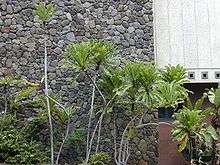Ficus pseudopalma
| Ficus pseudopalma | |
|---|---|
 | |
| Scientific classification | |
| Kingdom: | Plantae |
| (unranked): | Angiosperms |
| (unranked): | Eudicots |
| (unranked): | Rosids |
| Order: | Rosales |
| Family: | Moraceae |
| Genus: | Ficus |
| Species: | F. pseudopalma |
| Binomial name | |
| Ficus pseudopalma Blanco | |
Ficus pseudopalma is a species of fig known by the common names Philippine fig, dracaena fig, and palm-leaf fig.[1] In nature it is endemic to the Philippines, especially the island of Luzon.[1] It is known elsewhere as an ornamental plant.
This is a shrub growing erect with a naked unbranched stem topped with a cluster of leaves to give it the appearance of a palm.[2] Indeed, the species name pseudopalma means "false palm".[3] The leaves are up to 30 inches long and edged with dull teeth. The fruit is a dark green fig that grows in pairs, each fruit just over an inch long.[2]
In Luzon, this plant occurs in grassland and forest habitat, where it is considered common.[4] The new shoots of the plant are eaten as a type of vegetable, and there are a number of traditional medicinal uses, such as a remedy for kidney stones made from the leaves.[5] In Bicol Region the plant is known as Lubi-lubi and the leaves are cooked in coconut milk.[3] In 2003 the leaves were sold in markets for US$0.74 per kilogram, and the plant can be grown in plantations without pesticides for an adequate profit.[3]
This shrub has been used as a landscaping plant in Hawaii, but it never escaped cultivation or became established in the wild because the species of wasp that pollinates it was never brought to the islands.[2]
| Wikimedia Commons has media related to Ficus pseudopalma. |
References
- 1 2 GRIN Species Profile
- 1 2 3 Starr, F., et al. (2003). Ficus pseudopalma Fact Sheet. Hawaiian Ecosystems at Risk.
- 1 2 3 Food & Fertilizer Technology Center. (2003). Fruit and vegetables from the tropical forest. FFTC Practical Technology.
- ↑ Villegas, K. L. and F. A. Pollisco Jr. (2008). Floral survey of Laiban sub-watershed in the Sierra Madre Mountain Range in the Philippines. Journal of Tropical Biology and Conservation 4(1) 1-14.
- ↑ Ragasa, C. Y., et al. (2009). Terpenoids and sterols from the endemic and endangered Philippine trees Ficus pseudopalma and Ficus ulmifolia. Philippine Journal of Science 138(2) 205.